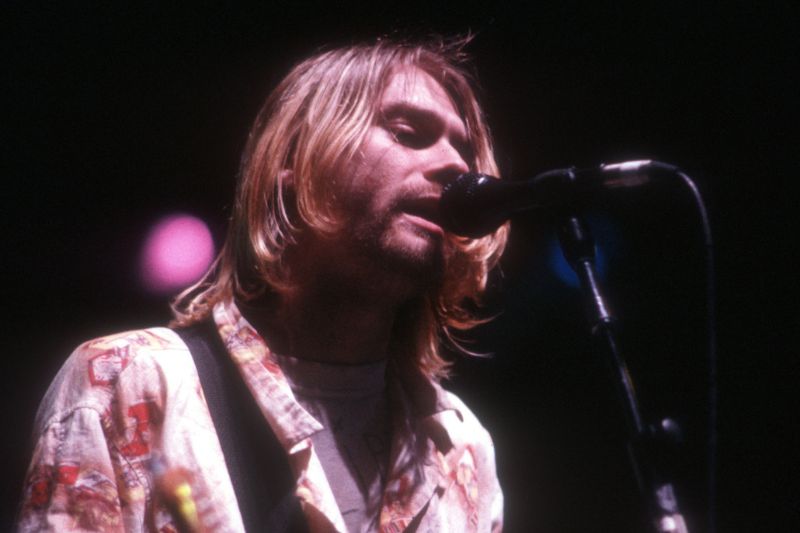Content warning: This article contains references to suicide.
In the video clip, the band emerges from a sepia-tinted gloom over an opening guitar riff that is playful, understated and instantly recognisable; the trashed-looking trio of young men then unleash a sonic onslaught that rips through a dingy high school gym. Black-clad cheerleaders twirl their pom-poms, while a sweaty, foot-stomping crowd of young people loses itself in grunge-fueled ecstasy. The pep rally devolves into a slow-mo moshpit and even the janitor rocks on. It’s playful without being joyful; it’s chaotic, it’s nihilistic, a shrugging off of everything that is restrictive and nice and conventional.

For those unfamiliar, ‘Smells Like Teen Spirit’ was a lodestone for Gen X and its raw power blasted Nirvana into the mainstream. Nirvana’s songwriter, frontman and tragedian Kurt Cobain was the music industry’s grunge bodhisattva, the undisputed music icon of his generation.
‘I was trying to write the ultimate pop song,’ Cobain explained in an interview with Rolling Stone’s David Fricke in 1994. Released on Nirvana‘s second album ‘Nevermind’, the grunge anthem reached No. 6 on the Billboard Hot 100, was a No. 1 hit internationally.
The lyrics are heavy with 90s-flavoured apathy. With the lights out it’s less dangerous, here we are now, entertain us. I feel stupid and contagious. Here we are now, entertain us. These words whisk us back to a decade that was, at once, more grungy and more grounded, a time when long hair and loose flannel reigned supreme, and in music venues the scent of sweat mingled with cigarette smoke. It was a bleaker era in some respects, yet paradoxically more hopeful in others; an age where rock was omnipresent and Cobain held court as the reluctant monarch of the disenchanted.
Cobain was born on 20 February 1967, died by his own hand on 5 April 1994, some 30 years ago last month. He left behind a wife, a daughter, and millions of grieving fans. Within five years of his death, Rolling Stone crowned Cobain the posthumous Artist of the Decade, and internationally he was hailed as ‘an icon of authenticity, the kind of artist who fans and critics like to crown as the last true rock star’. The last true rockstar playing perhaps the last true iteration of rock.
Grunge music was a defiant reaction to the polished commercial rock of the 1980s, addressing ‘depression, angst, and disillusionment’ by blending ‘heavy metal and punk rock with introspective and angst-ridden lyrics, as well as a lo-fi production style’. Its biggest icons (and none were grungier than Nirvana) made music about alienation, social isolation, and the struggles of everyday life.
You’ll remember how that iconic refrain Here we are now, entertain us, became a rallying cry for 90s youth, capturing their angst-ridden discontent. This was a generation that grew up in the shadow of the 1980s’ consumer-driven optimism, only to find themselves grappling with a more cynical, media-saturated environment, with its flood of idealised images and relentless marketing. And beneath the sheen of 90s prosperity lurked economic uncertainty, driven by globalisation and technological advances reshaping the job market. Nirvana’s self-conscious cynicism with an increasingly consumerist status quo captured the zeitgeist of a generation that, while living in unprecedented wealth, was unhappy with what it saw.

Curiously, it was inspired by something Cobain and his friends would say at parties, the Nirvana frontman revealed in the Rolling Stone interview. ‘A lot of times, when you’re standing around with people in a room, it’s really boring and uncomfortable. So it was “Well, here we are, entertain us. You invited us here”.’ Cobain’s widow Courtney Love recently shared an early draft of the lyrics, which, although clunkier and heavy-handed in their sense of angsty frustration, allow a peek inside the mind of their creator.
‘Come out and play / make up the rules / I know I hope / to buy the truth / who will be the king and queen / of all the outcasted teens. We’re so lazy / and so stupid / blame our parents / and the cupids / a deposit, for a bottle / stick it inside / no role model.’
So what was it about Cobain’s music that so resonated with young people in the late 80s and early 90s, and indeed continues to find vast audiences 30 years later? It was not just that he was one of the most lyrically adept artists of the late 20th century. There was something about Cobain, about Nirvana, that transcended the distorted guitar riffs, vulnerable vocals and unpolished musicianship.
Music journalist Robert Loss described it like this: ‘There are times when you hear Cobain sing that you can believe no other voice has ever told the truth about suffering.’ He noted that Cobain’s voice always sounded young, ‘the voice of a man in his early 20s who could reach back into his childhood and adolescence, neither of them particularly sunny, and call them up out of his throat.’ So, Cobain gave sound to the helplessness, the confusion, the scars of growing up and of being human.
Kurt Cobain was the archetypical tortured artist, mouth twisted in semi-permanent discomfort, but it’s important to remember he was also a man in pain. He struggled with mental illness and drug addiction. As a child he was diagnosed with Attention-deficit Hyperactivity Disorder, and reportedly diagnosed with bipolar disorder. Following his parents’ divorce, he became increasingly withdrawn. As a teenager he was socially isolated and the target of bullying. His catharsis included sleeping under bridges, taking drugs and vandalism. He also suffered from a chronic and debilitating stomach condition.
px.jpg)
In his 1992 interview with Cobain for Rolling Stone, Michael Azerrad wrote that Cobain told him, ‘Most of the concentration of my singing is from my upper abdomen, that’s where I scream, that’s where I feel, that’s where everything comes out of me — right here’. Azerrad noted that Cobain touched a point just below his breastbone, the locus of his stomach pain. The emotional rawness, the profound vulnerability in Cobain’s music is a transmogrification of physical and emotional pain into sound.
Cobain’s story is not unique; there have been far too many pained creative souls before and after him whose lives have ended miserably and prematurely. Artists who have followed a similar path include Taylor Hawkins (Foo Fighters), Chris Cornell (Soundgarden), Mikey Welsh (Weezer) and Chester Bennington (Linkin Park). Many others such as Lana Del Rey and Andy Nicholson (Arctic Monkeys) have opened up about contemplating or attempting suicide.
Many of us can relate to aspects of Cobain’s tale, at least to some degree, and for some of us his plight mirrors the experiences of our close mates. Cobain’s situation, however, was fettered with all the glittering excesses that accompany globe-dominating fame. The visionary Romantic poet and painter William Blake believed ‘the road to excess leads to the palace of wisdom’. The trajectory of Cobain’s life suggests there are far too many potential detours on that road, making Blake’s assertion a difficult one to accept without reservations.
What is it about the tortured artist that entrances us? French artist and writer Antonin Artaud referred to the preternaturally gifted yet tormented painter Vincent Van Gogh as Le Suicidé de la Société. Western culture tends to mythologize artists who find life unbearable, casting them as sacrificial – almost religious – figures. They become scapegoats of sorts, symbolic of all that is misunderstood, outcast and alienated, while at the same time remaining widely beloved.
The prominence of Cobain’s suicide arguably contributed to more open discussion of mental health issues, as well as fears of copycats and ideation through example (mostly dismissed, but seen in popular culture such as the American Preacher character ‘Arseface’, who survives a similar suicide attempt.)
In 1996, two years after Cobain’s death, the US National Library of Medicine presented data from the Seattle Medical Examiner's Office and from the Seattle Crisis Center ‘to assess the potential impact of Cobain's death on completed suicides and the incidence of suicide crisis calls’. The expected ‘Werther effect’ (shorthand for media-induced imitation of suicidal behaviour based on the protagonist of Goethe’s 1774 novel The Sorrows of Young Werther who commits suicide and prompted reports of mass copycat suicides following publication) apparently did not occur, but there was ‘a significant increase in suicide crisis calls following his death.’ And according to a 2014 article from Psychiatric Times, ‘the number of suicides actually fell in the wake of Cobain’s death as a function of a well-coordinated public health outreach effort’.
The suffering caused by mental illness, like that experienced by Cobain, continues to wreak havoc on young lives. Suicide is the leading cause of death for Australians aged 15–24, with 304 young Australians taking their lives in 2022. Many of the people in our communities experience uncertainty and fear; alienation, rejection, substance abuse and a crippling lack of self-belief. And for young people, loneliness and psychological distress has in recent years seen a dramatic increase. Perhaps that’s part of the reason Cobain’s message of rejection, hurt and empathy still hits home; the number of people who suffer from that same hopeless disaffection has not dinimished in the intervening 30 years, it has grown.
Now, decades after Cobain's death, nostalgia, hope and aspiration has led to a new Gen Z demimonde of fans, with ‘plenty of women and LGBTQ+ fans [pivoting] towards 90s alternative bands, including Nirvana’.
Kurt was only 27 when he died; 27 years old, for God’s sake. He was tortured and talented. By his successes and his failures, he found himself transformed into a many-headed beast of lover, father, guru, friend, leader, rebel and confidante. He was plagued by insecurities and ill health; he was scourged by the demons, yet Cobain was loved and worshipped. Legions of believers identified with him and the art that came from his suffering shaped a generation. And those who sang, danced, drank and laughed along do so still.
If you or someone you know is struggling with feelings of depression or suicidal ideation, call Lifeline on 13 11 14.
Barry Gittins is a Melbourne writer.
Main image: Kurt Cobain. (Getty Images)